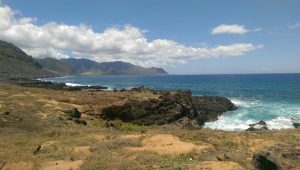We spent our last day on Oahu at Ka’ena Point Natural Area Reserve. Located at the westernmost tip of the island, Ka’ena Point is a sanctuary for native Hawaiian flora and fauna. It is home to the largest Laysan Albatross nesting colony in the main Hawaiian Islands. It is also said to be the place where Hawaiian souls leap from this world to join their ancestors the afterlife. As we hiked along the bumpy dirt road to the point, it was easy to see why this place is considered one of the most culturally and biologically important places on Oahu.

Lindsay Young of Pacific Rim Conservation joined us on our hike and shared her extensive knowledge of the albatross colony, which she has been studying for the past twelve years. As we approached the colony, Lindsay spotted an unbanded adult albatross waddling up ahead. Calmly, she walked up to the bird and tucked him under one arm while making sure its beak was secure in her other hand. As the resident bird-nerd of the class, I was beyond excited when Lindsay carefully transferred the albatross into my arms so she could apply one metal and one plastic band to each of his (or her) legs. After losing a few feathers for genetic testing, the albatross was ready to take off into the wind. Now, after less than five minutes of handling, Lindsay can not only track that albatross using its unique band numbers, but she can also determine its sex, find out who its parents are, and identify its future offspring. This information is crucial for monitoring the population.

The introduction of humans to the Hawaiian Islands caused significant declines in albatross and other seabird populations. More recently, albatross have suffered due to long line fishery interactions and predation from introduced species. While improved fishing practices have reduced seabird bycatch, albatrosses are still vulnerable to introduced predators. Lindsay and her husband, Eric VanderWerf, led the charge to fix this problem at Ka’ena point by installing a predator exclusion fence to keep dogs, cats, mongooses, rats and mice out of the seabird colony. The fence was completed in 2011 and all predators were eradicated from inside the colony. Since then, record numbers of Laysan albatross and wedge-tailed shearwaters have fledged from the colony and native vegetation has started to recover.
Despite this success story, it has not been all good news for the albatross colony at Ka’ena Point. This past winter, Hawaiians were shocked when teenagers entered the reserve and killed 15 nesting albatross pairs and destroyed their eggs. The case is still under investigation as State and Federal agencies gather evidence against the suspects. Lindsay, looking on the bright side, hopes this tragedy will help spread awareness and bring people together to protect this vulnerable species.

As we ate our lunch and looked out over the Pacific Ocean, it was hard to imagine that something so horrible could happen in such a peaceful place. Hawaiian monk seals rested on the rocks and seabirds soared on the horizon. Tracey Mercer, a monk seal expert from NOAA, spotted a seal in need of a vaccine against morbillivirus. Although she couldn’t safely access the seal, she gave us a demonstration of how she would administer the shot with a quick poke, which the seals barely notice. This particular seal will have to wait until NOAA scientists can return to receive the vaccine, which protects them from a potentially deadly disease.
After lunch, half of us trekked back into the colony to weigh albatross chicks, while the others stayed with Tracey to learn more about the monk seals. The albatross chicks are fat with fish oil delivered straight from the Bering Sea. By July, they will have traded their fluffy brown down for elegant black and white feathers and will take off to forage across the Pacific Ocean. In about seven years, they will return to their natal colony to find a lifelong mate and raise their own chick.

Exhausted from a long day in the hot sun, we hiked back to our vans and stopped for some much needed hydration on the way back to Honolulu. As I heard my (marine-mammal-loving) classmates talk about how amazing the albatrosses were, I felt like I wasn’t the only bird-nerd on the trip. Hopefully, these majestic creatures will continue to inspire visitors at Ka’ena Point to protect Hawaii’s vulnerable marine wildlife.
